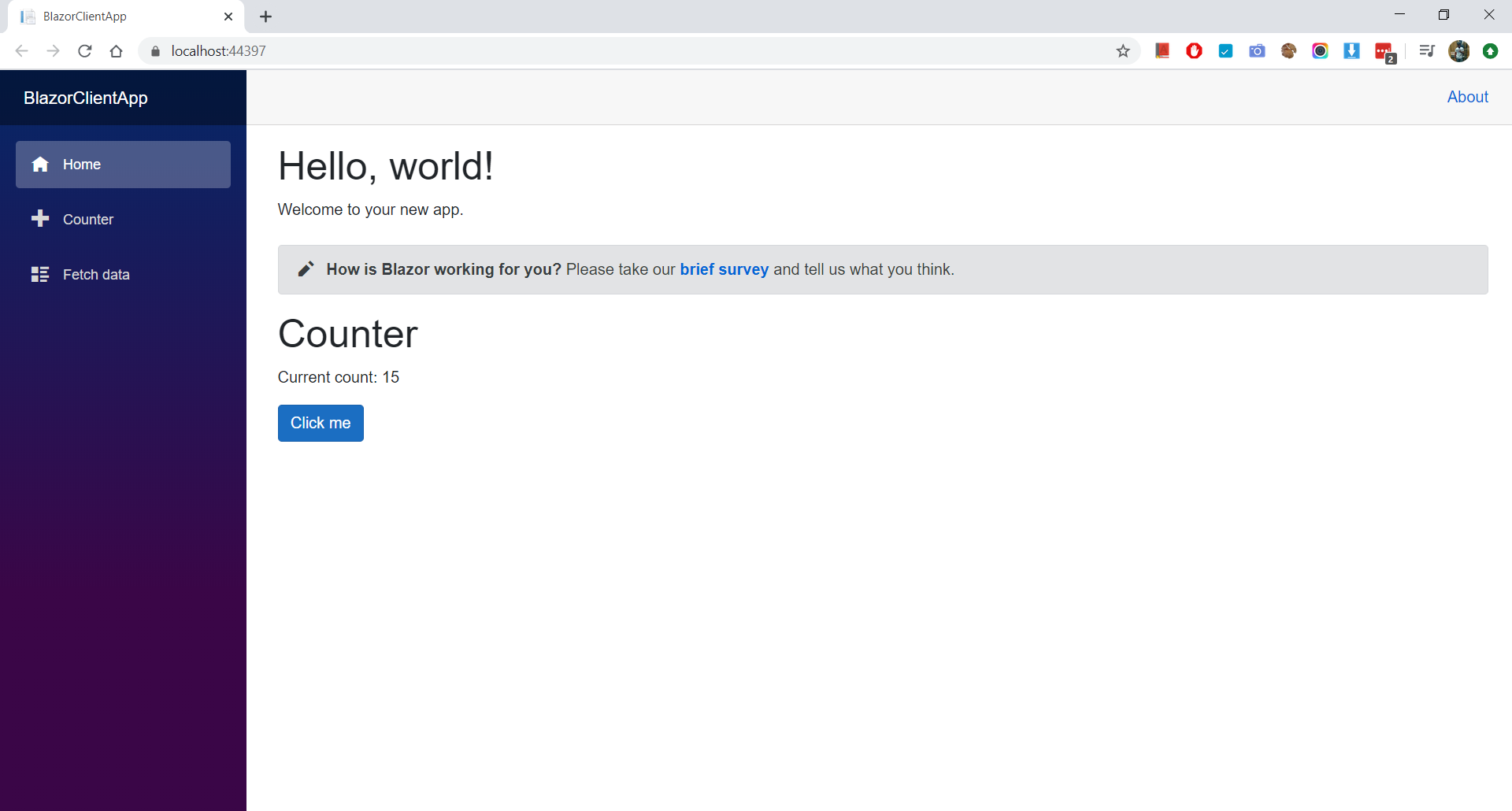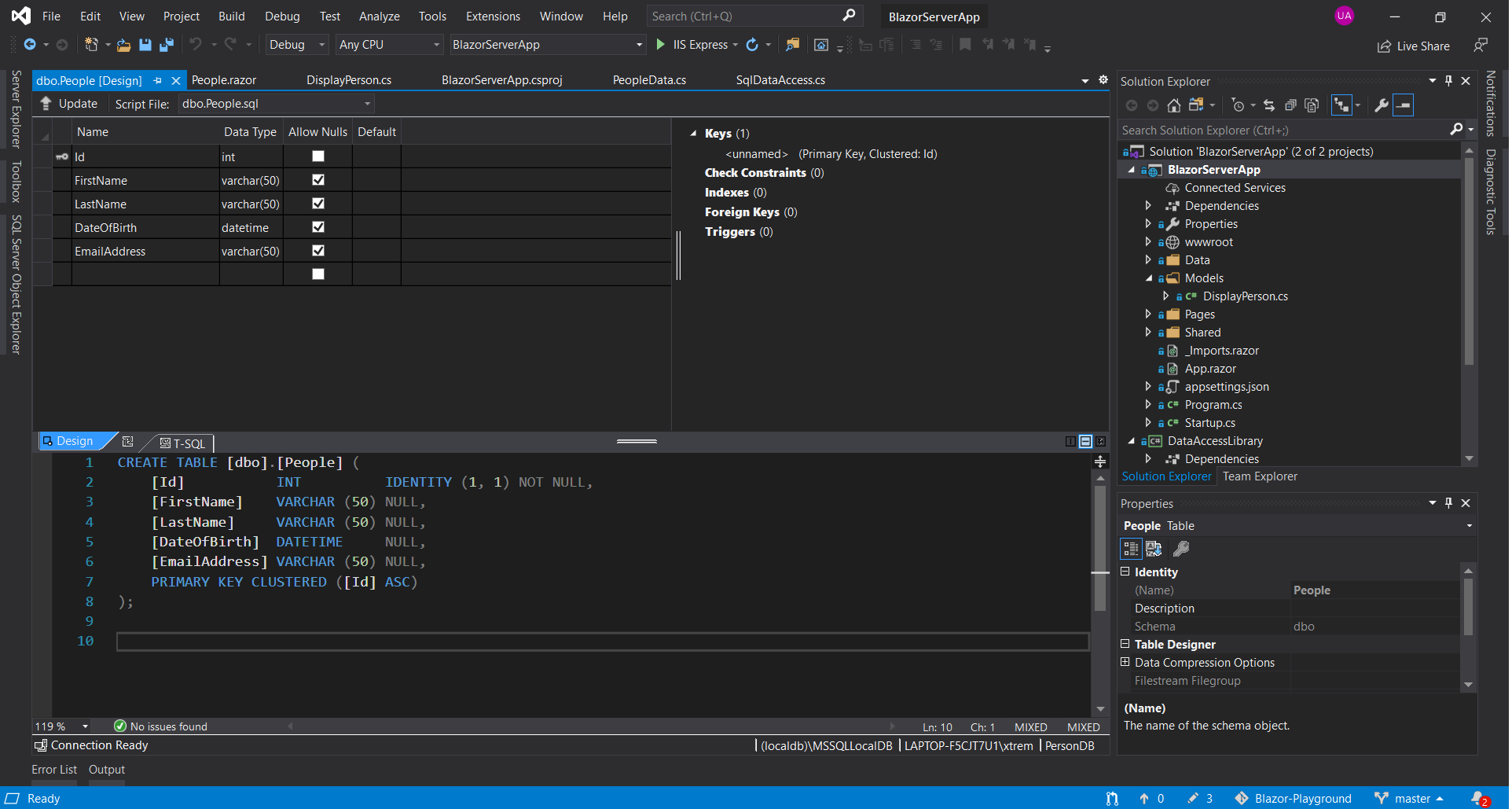Me, myself and I playing around and continusouly learning with Blazor tid bits... for the love of learning and building kickass stuff with .NET platform! ;)
Project /BlazorClientApp
- Splitting Counter.razor file with the Counter.razor.cs code behind implementation.
public class CounterBase : ComponentBase
{
[Parameter]
public int CurrentCount { get; set; } = 0;
public void IncrementCount(){ ... }
}- Extending from ComponentBase and inherited
@inherits CounterBaseinto Counter.razor page - Added Counter.razor as a Component into the Index.razor page
- Switched from
HttpClient.GetFromJsonAsync()toHttpClient.GetAsync()with the use of System.Text.Json.JsonSerializer - Blazor Client renders content in Client's Web Browser
- Blazor Client Apps = Blazor WebAssembly Apps
- Blazor Client Apps cannot directly debug in Visual Studio
Project /BlazorTodoApp
- In-Memory todo list created in Todo.razor page
- Adding the Navigation path in NavMenu.razor
- Data binding with
@bind="newTodo"across web UI elements - Adding Bootstrap css decorations for the elements
https://www.youtube.com/watch?v=CaxR4_fP-FA
Project /BlazorPersonApp
- ASP.NET Hosted Blazor Client App solution was created.
- Added a
PersonControllerAPI endpoint in the BlazorPersonApp.Server project - Implemented Get and Post endpoints in the PersonController and implemented calls to pull data for the Client App
https://www.youtube.com/watch?v=8DNgdphLvag
Project /BlazorServerApp
- You can mix and mingle ASP.NET Core UI Components and Bootstrap Css Style
...
<InputText class="form-control" placeholder="First Name"
id="firstName" @bind-Value="_newPerson.FirstName" />
...- Using
EditFormComponent withDataAnnotationsValidatorfor validating data model
<EditForm class="form-group" Model="@_newPerson" OnValidSubmit="InsertPerson">
<DataAnnotationsValidator />
<ValidationSummary />
...
<EditForm>- Make sure to create a local Database and set up the following table
CREATE TABLE [dbo].[People] (
[Id] INT IDENTITY (1, 1) NOT NULL,
[FirstName] VARCHAR (50) NULL,
[LastName] VARCHAR (50) NULL,
[DateOfBirth] DATETIME NULL,
[EmailAddress] VARCHAR (50) NULL,
PRIMARY KEY CLUSTERED ([Id] ASC)
);- Blazor Server renders content in Server, and uses SignalR WebSockets to transfer data back and forth
- Blazor Server Apps can directly debug in Visual Studio
- How to identify Blazor Server project? in the Startup.cs look for
services.AddServerSideBlazor();
https://www.youtube.com/watch?v=JE0tQ4tx0Nc
Project /BlazorComponentsApp
- Created the simple TaskList Component and reused it multiple times in a single page
- You can use multiple Components in a single page
- You can also Nest components within each other
- Remove
@page "/TaskList"so it can't be used as a page
https://github.com/dotnet-presentations/blazor-workshop/
Project /BlazingPizzaApp
- The most comprehensive end to end blazor self learning experience ever!
- Its better to build Page UIs with separate Components put together.
NavigationManagerallows you to programmatically Navigate in your Blazor app.- Save the state of a page in the DI container
builder.Services.AddScoped<OrderState>(); - Saving the state will help you retain data during page navigation
- Using Annotations on the data model you can easily implement Server side data validation
- Using
EditForm, you implement client side data validation - A nicer way to display input data field validation is by using
ValidationMessage. [Authorize]on the API Controller, to enforce Authorization for all incoming calls.- To enable the authentication services, for your Blazor Client add a call to
AddApiAuthorizationin Program.cs RemoteAuthenticatorViewcomponent orchestrates the authentication flow.CascadingAuthenticationStatewraps to let you inherit auth state to child elements.AuthorizeViewwill let you control displaying of elements based on auth state.- Use the
IAccessTokenProviderinjected to the pages for aquire AccessTokens. AuthenticationStateTasklets you check programmatically if the user is logged in or not.AuthorizeRouteViewcontrols the direct access to routes based on auth state- Redirecting will make you lose state, but you can preserve it by implementing
RemoteAuthenticationState. - Inject
IJSRuntimeto invoke JavaScript functions withJSRuntime.InvokeVoidAsync()method. - Build Templated Components to increase the reusability of Components.
- Easily set up PWA features (installable, offline, push notifications) for Blazor, with
service-worker.jsconfiguration. - Use
WebPushto set up Push Notifications in your Blazor application and Server backend. - Displaying and handling the received Push Notification is set up in
service-worker.js. - To Publish to Azure, you need to create an
App ServiceandHosting Planof Basic tier or higher. - Finally you need to set up a signing key with
Azure Key Vaultfor the IdentityServer.






